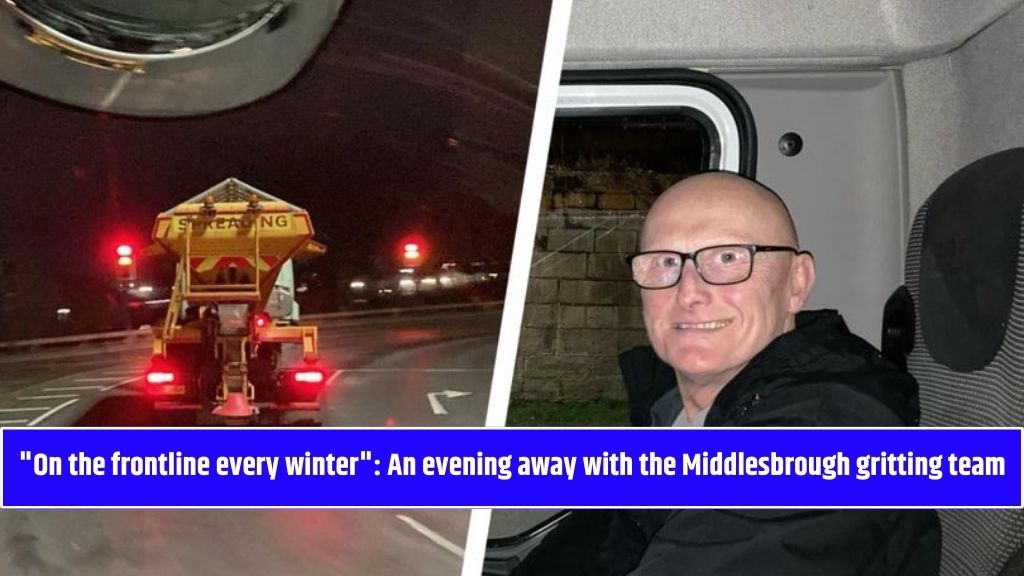When winter arrives, keeping roads safe becomes a top priority for Middlesbrough Council. Behind the scenes, a dedicated team works tirelessly to ensure the town’s key routes remain ice-free and safe for motorists. On Thursday, February 13, I joined the Middlesbrough gritting team to see firsthand the effort and skill involved in this crucial operation.
The Night Begins: Preparing for the Grit Run
My journey into the world of gritting began with Mark Wilson, a gritting group leader with over 13 years of experience in the role. When I met Mark at Resolution House on Cargo Fleet Lane at 7:30 pm, he had already prepared the five gritters for the night’s task, each loaded with 3.5 tonnes of grit.
“Tonight it’s only a mild frost, so 10 grams tonight. If it’s heavy frost or snow, it’s 20 grams. Sometimes, you’re out doing two or three runs a night.” – Mark Wilson
The night’s task was to cover Priority Route Four – one of the five designated routes that span 180 miles of Middlesbrough’s most critical roads. Route Four would take us through Hemlington, Acklam, and Linthorpe.
Why Gritting Matters: Understanding Priority Routes
Middlesbrough Council’s gritting operation is carefully planned to ensure maximum road safety. There are five priority routes, each covering essential roads like:
- Route One: A66 and major connecting roads
- Route Four: Hemlington, Acklam, and Linthorpe
- Route Five: Middlehaven and the busy town centre
The council uses weather forecasts and road temperature sensors to decide how much grit to apply. For mild frost, like on this particular evening, 10 grams per square metre is sufficient. However, for heavier frost or snow, the team applies up to 20 grams – or more if conditions worsen.
In the Cab: Precision and Patience
As we set off, Mark explained the complexity involved in the gritting process. While it might seem as simple as spreading salt on roads, it actually requires skill, experience, and constant vigilance.
Key Tasks During a Grit Run:
- Adjusting the Spread Width: Mark used a control panel to his left to adjust the spread width based on road size.
- Stopping and Starting: The spreader was manually paused at route overlaps to avoid wasting grit.
- Navigating Roundabouts: We often had to circle each roundabout to ensure full coverage.
“I know my route like the back of my hand. On roundabouts, we need to do a full 360 to cover the surface properly.” – Mark Wilson
Behind the Scenes: Grit Supplies and Equipment
The council keeps 4,000 tonnes of grit on standby for the 2024/25 winter season. This might sound like a lot, but with multiple runs per night and three to four tonnes per vehicle, the supply can diminish quickly during a harsh winter.
Mark pointed out the spare gritter in the depot – essential for maintaining operations in case of a breakdown. Snowploughs were also ready to be mounted on the gritters if heavy snowfall hit the town.
The Team’s Dedication: Long Hours and Shifts
Gritting isn’t a standalone job; it’s an extra responsibility for the highways team during winter. Mark explained that he typically works a day shift from 6:00 am to 3:30 pm before taking on gritting duties.
“You could be out at 4 am after a full day shift. But if we work past midnight, we don’t have to be back at 6 am.”
The gritting team operates on a rotating shift system between October and April, with teams alternating week on, week off.
Challenges on the Road
While most drivers are grateful for the team’s work, others are less understanding.
“Some drivers give us a thumbs-up or a wave, which feels good. But others try to overtake dangerously or don’t give us space. We’re here to keep the roads safe – a bit of patience goes a long way.” – Mark Wilson
Mark also mentioned that gritting in the town centre can be particularly challenging, especially on weekend nights when revellers crowd the streets.
The Science Behind Gritting
Gritting works by spreading rock salt on roads. When vehicles drive over the grit, it mixes with any surface moisture to lower the freezing point of water, preventing ice formation.
Factors Influencing Grit Usage:
- Road Temperature: More grit is needed when temperatures fall below -5°C.
- Forecast Conditions: Snow or freezing rain requires multiple runs.
- Traffic Volume: Busier roads spread the grit more effectively.
Lessons from the Night
Spending time with Middlesbrough’s gritting team gave me a new appreciation for the behind-the-scenes work that goes into keeping our roads safe. The operation is far more complex and physically demanding than I had imagined.
Councillor Peter Gavigan, the council’s executive member for environment and sustainability, summed it up:
“The town relies on a clear and safe road network, and our brilliant gritting crews are on the frontline every winter, whatever the weather throws at us.”
| Visit for More News and Updates | WSOA NEWS |
